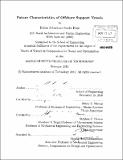Future characteristics of Offshore Support Vessels
Author(s)
Rose, Robin Sebastian Koske
DownloadFull printable version (12.78Mb)
Alternative title
Future characteristics of OSVs
Other Contributors
Massachusetts Institute of Technology. Computation for Design and Optimization Program.
Advisor
Henry S. Marcus and Stephen C. Graves.
Terms of use
Metadata
Show full item recordAbstract
The objective of this thesis is to examine trends in Offshore Support Vessel (OSV) design and determine the future characteristics of OSVs based on industry insight and supply chain models. Specifically, this thesis focuses on Platform Supply Vessels (PSVs) and the advantages of certain design characteristics are analyzed by modeling representative offshore exploration and production scenarios and selecting support vessels to minimize costs while meeting supply requirements. A review of current industry practices and literature suggests that offshore exploration and production activities will move into deeper water further from shore and as a result supply requirements will increase significantly. A review of the current fleet and orderbook reveal an aging fleet of traditional vessels with little deepwater capabilities and a growing, young fleet of advanced vessels capable of deepwater support. A single-vessel supply chain analysis shows that traditional vessels outperform larger vessels for shallow-water resupply activities, while modern vessels and vessels significantly larger than modern vessels are more cost-effective for deepwater operations. As offshore oilfield supply is more complicated than a single vessel supplying a single platform, we develop a mixed integer linear program model of the fleet selection process and implement it on representative offshore exploration and production scenarios. The model is used to evaluate the cost-effectiveness of representative vessels and the value of flexibility in vessel design for the oilfield operator. Incorporating industry insight into the results from the supply chain analyses, this study concludes that a) offshore exploration and production will move further offshore into deeper water, b) OSVs will become significantly larger both in response to the increased cargo need as well as to meet upcoming regulations, c) crew transfer will continue to be done primarily by helicopter, d) OSVs will become significantly more fuel efficient, e) high-specification, flexible OSV designs will continue to be built, and f) major oil companies will focus on safety and redundancy in OSV designs.
Description
Thesis (S.M.)--Massachusetts Institute of Technology, Computation for Design and Optimization Program, 2011. Cataloged from PDF version of thesis. Includes bibliographical references (p. 101-104).
Date issued
2011Department
Massachusetts Institute of Technology. Computation for Design and Optimization ProgramPublisher
Massachusetts Institute of Technology
Keywords
Computation for Design and Optimization Program.